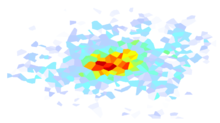Source code for shakelib.correlation.dummy
import numpy as np
from shakelib.correlation.ccf_base import CrossCorrelationBase
[docs]class DummyCorrelation(CrossCorrelationBase):
"""
Simplified correlation module for testing purposes. Should not be used
in productions runs as it does not produce valid correlations.
"""
def __init__(self, periods):
"""
Initialize the cross-correlation object.
Args:
periods (ndarray): An array of periods that will be requested
from the function. Values must be in the range [0.01, 10.0],
and must me sorted from smallest to largest.
Returns:
An instance of :class:`DummyCorrelation`.
"""
if np.any(periods < 0.01):
raise ValueError("The periods must be greater or equal to 0.01s")
if np.any(periods > 10):
raise ValueError("The periods must be less or equal to 10s")
self.periods = periods.copy()
[docs] def getCorrelation(self, ix1, ix2, h):
"""
Compute the correlation between two periods and a separation distance
of h km. The result returned is::
rho = T1/T2 * exp(-h/10)
where rho is the correlation, T1 is the smaller period, T2 is the
larger period, and h is the distance between the points of interest.
The index arrays (ix1 and ix2) and h array must have the same
dimensions. The
indices may be equal, and there is no restriction on which one is
larger. The indices refer to periods in the 'period' argument to the
class constructor.
Args:
ix1 (ndarray):
The indices of the first period of interest.
ix2 (ndarrays):
The indices of the second period of interest.
h (ndarray):
The separation distance between two sites (units of km).
The result is placed in h.
Returns:
h (ndarray): The predicted correlation coefficient. The output
array will have the same shape as the inputs.
"""
# Verify the validity of input arguments
if np.any(h < 0):
raise ValueError("The separation distance must be positive")
if np.shape(ix1) != np.shape(ix2) or np.shape(ix1) != np.shape(h):
raise ValueError("The input arguments must all have the same dimensions")
p1 = self.periods[ix1]
p2 = self.periods[ix2]
rho = p1 / p2
invix = rho > 1.0
rho[invix] = 1.0 / rho[invix]
ad = np.abs(h)
rho = rho * np.exp(-ad / 10)
h[:] = rho[:]
return h
